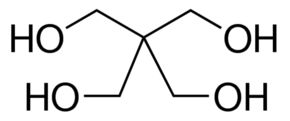HI! I’M ELEMENT AI.
Pentaerythritol

Product Description
Pentaerythritol is a versatile polyol compound with various industrial applications.
Product:
Pentaerythritol
CAS:
115-77-5
Synonym:
2,2-Bis(hydroxymethyl)-1,3-propanediol; Tetramethylolmethane
Structure:

Typical Characteristics
Appearance
White crystalline solid
Boiling point
276 °C (30 mmHg)
Density
1.39 g/cm3
Flash Point
240 °C
Melting point
253 - 258 °C
Molecular Weight
136.15
Purity
99 %
Refractive index
1.548
Uses, Applications & Markets
Key applications
get a quote
We Offer Pentaerythritol
in various grades
A few of the grades available are listed below:



Pentaerythritol used in many
industry applications
Pentaerythritol is a versatile polyol compound with various industrial applications. Here's a list of some of its uses:
- Alkyd Resins: Pentaerythritol is a key raw material in the production of alkyd resins, which are used as binders in paints, coatings, and varnishes. It provides excellent film-forming properties, durability, and weather resistance to the finished coatings.
- Explosives: Pentaerythritol is used in the manufacture of explosives, such as PETN (pentaerythritol tetranitrate), RDX (cyclotrimethylenetrinitramine), and nitroglycerin. It serves as a high-energy explosive ingredient due to its high density and stability.
- Plasticizers: Pentaerythritol esters are used as plasticizers in PVC (polyvinyl chloride) and other polymers to improve flexibility, softness, and processability. They are commonly used in wire and cable insulation, flooring, and automotive applications.
- Polyurethanes: Pentaerythritol is used in the production of polyurethane foams, elastomers, and coatings. It reacts with isocyanates to form crosslinked polyurethane networks, imparting excellent mechanical properties and chemical resistance to the final products.
- Synthetic Lubricants: Pentaerythritol esters are used as base oils or additives in synthetic lubricants and greases for automotive, industrial, and aerospace applications. They provide high lubricity, thermal stability, and oxidative stability, extending the service life of lubricated components.
- Fire Retardants: Pentaerythritol esters are used as flame retardants in plastics, textiles, and building materials. They act as char-forming agents, releasing water vapor and carbonaceous residues when exposed to fire, thereby reducing flammability and smoke generation.
- Rosin Esters: Pentaerythritol esters are used in the production of rosin ester tackifiers for adhesives and pressure-sensitive tapes. They improve adhesion, cohesion, and tackiness in hot melt and solvent-based adhesive formulations.
- Printing Inks: Pentaerythritol esters are used as modifiers in printing inks to improve gloss, flow, and adhesion on various substrates, including paper, cardboard, and plastics. They enhance print quality and drying characteristics in offset, gravure, and flexographic printing processes.
- Anti-corrosion Coatings: Pentaerythritol is used in anti-corrosion coatings for metal surfaces exposed to harsh environments, such as marine and industrial applications. It forms a protective barrier against moisture, chemicals, and UV radiation, preventing metal degradation and rust formation.
- Adhesives and Sealants: Pentaerythritol esters are used as tackifiers, plasticizers, and crosslinkers in adhesive and sealant formulations. They improve bond strength, cohesion, and flexibility in construction adhesives, automotive sealants, and structural adhesives.